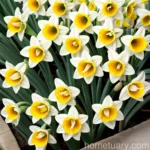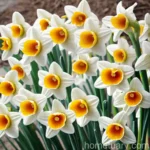Plant Scientist Blog: Split-Corona Daffodil (Narcissus ‘Colorama’)
Welcome to the world of plant science! Today, we will delve into the mesmerizing realm of split-corona daffodils, specifically the Narcissus ‘Colorama’ variety. As a plant scientist, it is truly an honor to share insights into the captivating features, cultivation, uses, and maintenance of this elegant flowering plant.
What is a Split-Corona Daffodil?
The split-corona daffodil, scientifically known as Narcissus ‘Colorama’, belongs to the Amaryllidaceae family. This striking perennial plant is renowned for its unique floral structure, characterized by a corona or trumpet that is distinctly split. The ‘Colorama’ variety is particularly cherished for its captivating blooms, adding a touch of elegance and vibrancy to gardens, landscapes, and indoor settings.
Key Takeaways – Split-Corona Daffodil (Narcissus ‘Colorama’)
Let’s embark on an enlightening journey to unravel the key aspects of split-corona daffodils, focusing specifically on the Narcissus ‘Colorama’ variety. We will explore its culture, uses, water requirements, sunlight preferences, fertilizer needs, soil characteristics, pruning techniques, propagation methods, and its popularity among garden enthusiasts.
Culture
- Genus and Species: Narcissus ‘Colorama’
- Family: Amaryllidaceae
- Plant Type: Perennial
- Flower Shape: Split-corona with distinct trumpet
Uses
- Garden Borders: Adds a vibrant touch to garden borders and edges.
- Container Gardening: Ideal for containers and pots, enhancing the beauty of balconies and patios.
- Cut Flowers: Stunning cut flowers for floral arrangements and indoor decor.
- Landscape Focal Points: Creates captivating focal points in outdoor landscapes.
Water
- Watering Frequency: Regular watering, ensuring moist but well-drained soil.
- Watering Season: Adequate watering during the growing and blooming seasons.
- Watering Method: Direct soil watering; avoid wetting the foliage and flowers.
Sunlight
- Sun Exposure: Prefers partial to full sunlight for 4-6 hours daily.
- Indoor Light: Suitable for well-lit indoor spaces with ample natural light.
- Sunlight Intensity: Thrives in bright, indirect light when grown indoors.
Fertilizer
- Fertilizer Type: Balanced, water-soluble fertilizer for flowering plants.
- Fertilizing Schedule: Apply fertilizer during the growing season, following package instructions.
- Application Method: Diluted fertilizer solution applied to the soil around the plant base.
Soil
- Soil Type: Well-draining, fertile soil with a slightly acidic to neutral pH.
- Soil Composition: Loamy or sandy soil enriched with organic matter.
- Soil Moisture: Moist but not waterlogged; avoids water stagnation.
Pruning
- Pruning Time: After blooming, trim the flower stalks to ground level.
- Deadheading: Remove spent blooms to encourage the plant’s energy toward bulb development.
- Foliage Care: Allow the foliage to wither naturally before trimming to promote bulb nourishment.
Propagation
- Method: Offsets or bulb division; dividing and replanting mature bulbs.
- Propagation Time: Late summer or early autumn for optimum establishment.
- Planting Depth: Plant bulbs at a depth of about 6 inches (15 cm) in well-prepared soil.
Container Popularity
- Outdoor Containers: Enhances the beauty of outdoor containers and balcony gardens.
- Indoor Pots: Ideal for indoor cultivation, bringing the allure of spring indoors.
- Decorative Uses: Creatively used in container gardening for ornamental purposes.
Common Diseases and Pest Control
Common Diseases
- Fungal Infections: Watch for signs of botrytis, fusarium, and other fungal diseases.
- Viral Attacks: Guard against mosaic virus and other viral infections.
- Bulb Rot: Prevent bulb rot by ensuring well-draining soil and proper ventilation.
Disease Diagnosis
- Visual Symptoms: Discoloration, spotting, wilting, and deformities in leaves and flowers.
- Bulb Inspection: Check for signs of rot, mold, or abnormalities in the bulbs.
- Professional Consultation: Seek advice from local horticulturists for accurate diagnosis and treatment guidance.
Common Pests
- Aphids: Monitor for aphid infestations, especially on young shoots and flower buds.
- Thrips: Look for thrips in the flower heads, causing damage to petals and reproductive parts.
- Nematodes: Protect against nematode damage to the roots, affecting overall plant health.
Pest Control Measures
- Natural Predators: Encourage beneficial insects like ladybugs and lacewings to control aphid populations.
- Neem Oil Spray: Apply neem oil as a natural remedy for aphids, thrips, and mites.
- Soil Treatment: Consider soil drenches with organic pest control solutions for nematode management.
Botanist’s Tips
As plant enthusiasts, it is essential to embrace the art and science of cultivating split-corona daffodils. Here are some valuable tips to ensure the success and vibrancy of Narcissus ‘Colorama’ in your green spaces:
- Site Selection: Choose well-drained spots for planting to avoid waterlogging and root rot.
- Bulb Inspection: Prior to planting, examine bulbs for firmness, size, and absence of visible damage or mold.
- Naturalizing Technique: Scatter bulbs and plant them where they fall to create a naturalized effect over time.
- Seasonal Maintenance: Monitor the plant’s progress throughout the growing seasons, adjusting care as needed.
- Winter Protection: Provide mulch or protective cover for bulbs in colder climates to safeguard against frost.
Fun Facts
- Cultural Significance: Daffodils symbolize rejuvenation, hope, and the arrival of spring in many cultures.
- Naturalizing Beauty: Over time, split-corona daffodils can become established in grassy areas, creating breathtaking displays.
- Colorama Variety: The ‘Colorama’ cultivar is celebrated for its vibrant color combinations, making it a standout in gardens and landscapes.
Links to External Resources
For further exploration of split-corona daffodils, gardening techniques, and horticultural inspiration, I highly recommend the following resources:
- Royal Horticultural Society – Daffodil Growing Guide
- American Daffodil Society
- Gardening Know How – Daffodil Care and Growing Tips
Conclusion
In conclusion, the split-corona daffodil, Narcissus ‘Colorama’, stands as a testament to the beauty and resilience of nature. As we nurture and appreciate these alluring flowers, we become stewards of natural elegance and botanical wonder. I hope this exploration has ignited your curiosity and passion for the enchanting world of split-corona daffodils, inspiring you to embrace the art of cultivating and cherishing these captivating blooms in your own botanical haven.
Thank you for joining me on this botanical journey, and may your gardening adventures be filled with the grace and allure of Narcissus ‘Colorama’!
Happy Gardening!
References available upon request.















